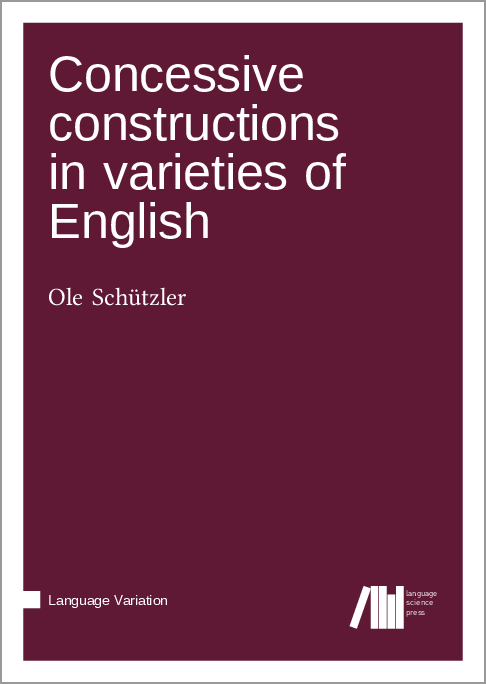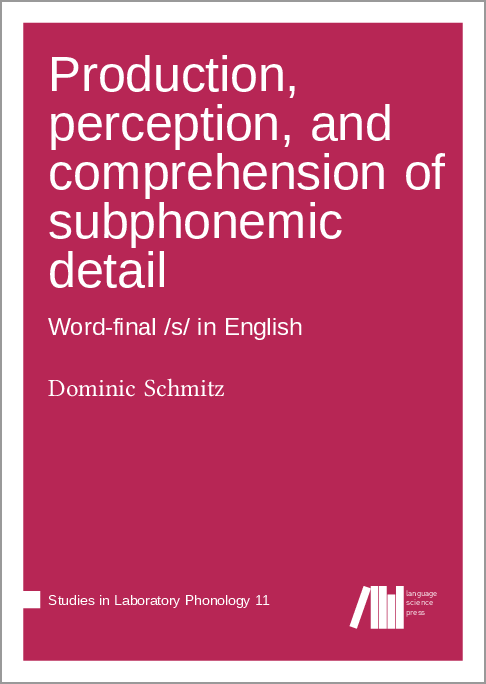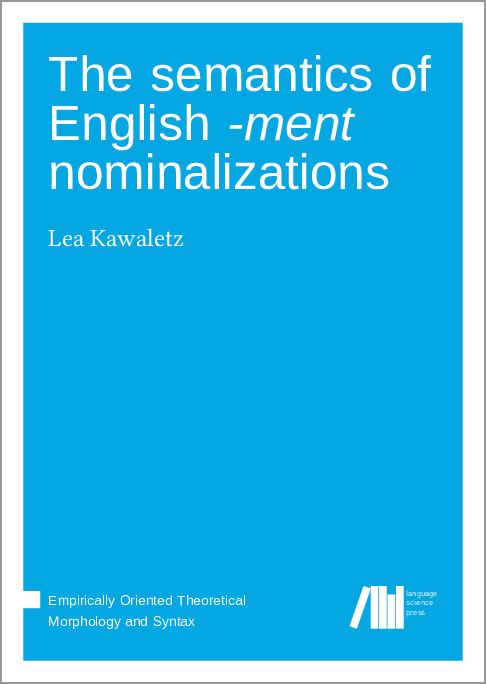In der letzten Zeit sind u.a. diese frei verfügbaren Titel erschienen:
Concessive constructions in varieties of English
Ole Schützler
https://langsci-press.org/catalog/book/370
https://doi.org/10.5281/zenodo.8375010
This volume presents a synchronic investigation of concessive constructions in nine varieties of English, based on data from the International Corpus of English. The structures of interest are complex sentences with a subordinate clause introduced by although, though or even though.
Various functional and formal features are taken into account: (i) the semantic/pragmatic relation that holds between the propositions involved, (ii) the position of the subordinate clause, (iii) the conjunction that is used, and (iv) the syntax of the subordinate clause.
By exploring patterns of variation from a Construction Grammar perspective, the study works towards an explanatory model, whose point of departure is at the functional (semantic/pragmatic) level, and which makes hierarchically organised predictions for different formal levels (clause position, choice of connective and realisation of the subordinate clause). It treats concessives as complex form-function pairings, and develops arguments and routines that may inform quantitative approaches to constructional variation more generally.
Production, perception, and comprehension of subphonemic detail: word-final /s/ in English
Dominic Schmitz
https://langsci-press.org/catalog/book/365
https://doi.org/10.5281/zenodo.7267830
The complexities of speech production, perception, and comprehension are enormous. Theoretical approaches of these complexities most recently face the challenge of accounting for findings on subphonemic differences. The aim of the present dissertation is to establish a robust foundation of findings on such subphonemic differences.
One rather popular case for differences in subphonemic detail is word-final /s/ and /z/ in English (henceforth S) as it constitutes a number of morphological functions. Using word-final S, three general issues are investigated. First, are there subphonemic durational differences between different types of word-final S? If there are such differences, how can they be accounted for? Second, can such subphonemic durational differences be perceived? Third, do such subphonemic durational differences influence the comprehension of S?
These questions are investigated by five highly controlled studies: a production task, an implementation of Linear Discriminative Learning, a same-different task, and two number-decision tasks. Using not only real words but also pseudowords as target items, potentially confounding effects of lexical storage are controlled for.
Concerning the first issue, the results show that there are indeed durational differences between different types of word-final S. Non-morphemic S is longest in duration, clitic S is shortest in duration, and plural S duration is in-between non-morphemic S and clitic S durations. It appears that the durational differences are connected to a word’s semantic activation diversity and its phonological certainty. Regarding the second issue, subphonemic durational differences in word-final S can be perceived, with higher levels of perceptibility for differences of 35 ms and higher. In regard to the third issue, subphonemic durational differences are found not to influence the speed of comprehension, but show a significant effect on the process of comprehension. The overall results give raise to a revision of various extant models of speech production, perception, and comprehension.
The semantics of English ‑ment nominalizations
Lea Kawaletz
https://langsci-press.org/catalog/book/349
https://doi.org/10.5281/zenodo.7915801
It is well-known that derivational affixes can be highly polysemous, producing a range of different, often related, meanings. For example, English deverbal nouns with the suffix -er can denote instruments (opener), agents (writer), locations (diner), or patients (loaner). It is commonly assumed that this polysemy arises through a compositional process in which the affix interacts with the semantics of the base. Yet, despite intensive research in recent years, a workable model for this interaction is still under debate.
In order to study and model the semantic contributions of the base and of the affix, a framework is needed in which meanings can be composed and decomposed.
In this book, I formalize the semantic input and output of derivation by means of frames, that is, recursive attribute-value structures that serve to model mental representations of concepts. In my approach, the input frame offers an array of semantic elements from which an affix may select to construct the derivative’s meaning.
The relationship between base and derivative is made explicit by integrating their respective frame-semantic representations into lexical rules and inheritance hierarchies.I apply this approach to a qualitative corpus study of the productive relationship between the English nominalizing suffix -ment and a semantically delimited set of verbal bases. My data set consists of 40 neologisms with base verbs from two semantic classes, namely change-of-state verbs and verbs of psychological state. I analyze 369 attestations which were elicited from various corpora with a purposeful sampling approach, and which were hand-coded using common semantic categories such as event, state, patient and stimulus.
My results show that -ment can target a systematically restricted set of elements in the frame of a given base verb. It thereby produces a range of possible readings in each derivative, which becomes ultimately interpretable only within a specific context. The derivational process is governed by an interaction of the semantic elements provided by the base on the one hand, with properties of the affix (e.g. -ment’s aversion to [+animate] readings) on the other. For instance, a shift from the verb annoy to a result-state reading in annoyment is possible because the input frame of verbs of psychological state offers a RESULT-STATE attribute, which, as is fixed in the inheritance hierarchy, is compatible with -ment. Meanwhile, a shift from annoy to an experiencer reading in annoyment fails because the value range of the attribute EXPERIENER is fixed to [+animate] entities, so that -ment’s animacy constraint blocks the inheritance mechanism.
Furthermore, a quantitative exploration of my data set reveals a likely blocking effect for some -ment readings. Thus, while I have found most expected combinations of nominalization and reading attested, there are pronounced gaps for readings like instrument or stimulus. Such readings are likely to be produced by standardly subject-denoting suffixes such as -er or -ant, which may reduce the probability for -ment derivation. The quantitative analysis furthermore shows that, within the subset of attested combinations, ambiguity is widespread, with 43% of all combinations of nominalization and reading being only attested ambiguously.
This book shows how a derivational process acts on the semantics of a given verbal base by reporting on an in-depth qualitative study of the semantic contributions of both the base and the affix. Furthermore, it demonstrates that an explicit semantic decomposition of the base is essential for the analysis of the resulting derivative’s semantics.



